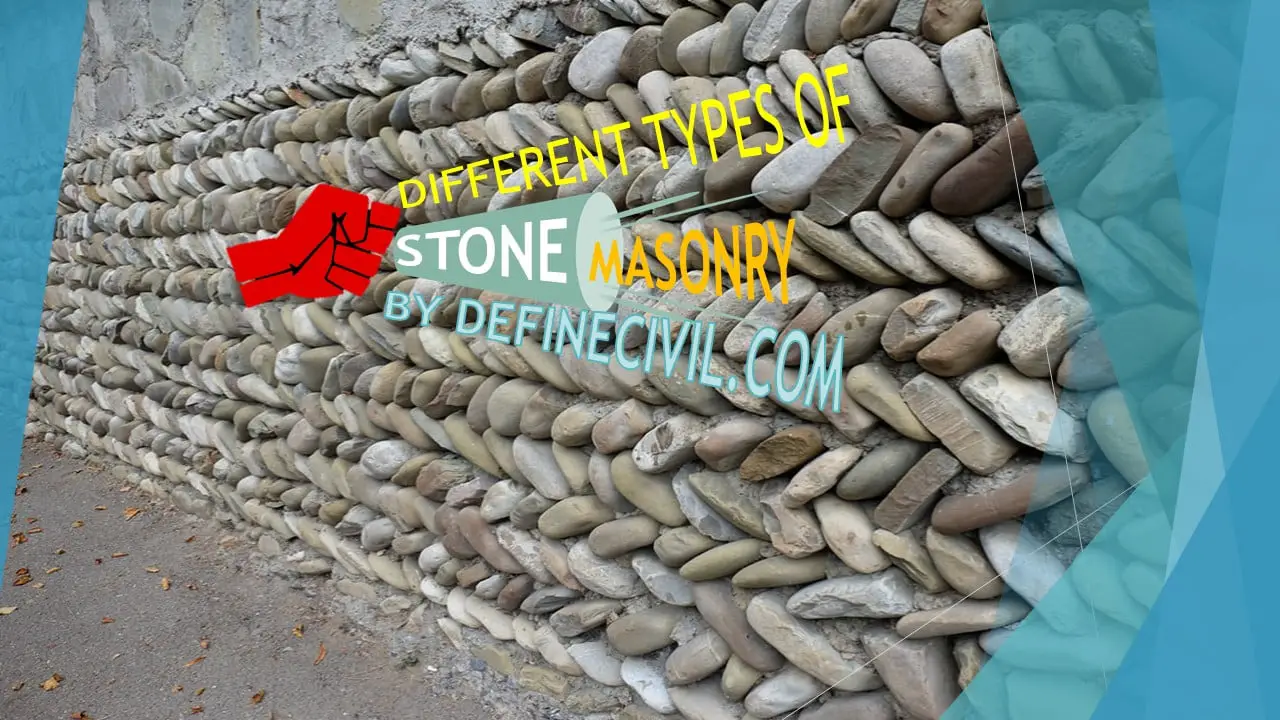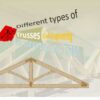Although different types of stone masonry were in use from ancient times for construction of hideouts and houses, but owing to the durability and sturdiness they still are a popular choice among construction peers.
Can you imagine, if the great Egyptian pyramids would had built by bricks, could had survived till now? In fact, most of the ancient monuments and structures that has survived the testing time of history are built by stones.
Still now, we have tremendous applications of various types of stone masonry, including but not limited to retaining walls, breast walls, bridge abutment walls, piers, dams, extensive erosion protection works for different embankments.

What is Stone Masonry?
Stone is nothing but a rock that is removed from its natural site and is then dressed or chiseled in a shape suitable for laying out in courses by a mason in a process called masonry.
As a matter of fact, while of my work in current project, I am witnessing these above stated applications of stone masonry whilst the project is a mega scale scope.
You are here as it is very easy to fall in the trap of stone masonry because of their number of benefits and pluses. But as there are many types of stone masonry, it is always a tricky decision to select the type suiting and matching the needs of the project.
So in this I would be going through all the types of stone masonry stating their pros and cons along with their uses in various situations and this would make you at ease while deciding the type.
The only classification of stone masonry is based on fineness in stone shape and its sequencing in a course while laying.
[su_box title=”IMPORTANT !!!” box_color=”#e94b52″]If you are looking for different types of Brick Masonry this article will guide you comprehensively. Types of Brick Masonry[/su_box]
Basic Types of Stone Masonry
There are two types of stone masonry namely
- Ashlar Masonry
- Rubble Masonry
Ashlar Masonry
Ashlar are those stones that are finely dressed in a square or rectangular shape i.e. free from any irregularity or defects. Care must be taken while dressing the stone so their sizes and dimensions must be in accordance with the thickness of wall and a height of course.
The joints in this type of masonry are finely made with thickness of around 3 mm or so. In most of the cases the ashlar masonry is carried out in cement mortar or in some cases lime mortar.
This type of stone masonry is costly and time taking as it involves extensive dressing work and only expert masons having experience of ashlar masonry must be hired. So for most of the cases we can find the application of Ashlar Masonry only in building that are large and important like fortresses, palaces etc.
Types of Ashlar Masonry
When naming any type of ashlar masonry, it is related to the quality or specification of the face finish of the stones used.
-
Ashlar Rough Tooled
Keeping in view of the above stated rule, we can relate that ashlar rough tooled is that type of ashlar masonry in which the face of the stones is rough tooled. So Ashlar rough tooled types of ashlar masonry is the one in which sides and the bed is dressed properly with fine chisel tool thereby drafting all the corners. The height of the stones in each course may not be kept same but it is selected keeping in view the symmetry along with structural integrity of the wall.
It had a well-made joint with reasonable thickness i.e. usually less than 6 mm. The corners of the stone around the periphery are finely dressed by drafting.
-
Ashlar fine Masonry
In Ashlar fine type of stone masonry, unlike the ashlar rough masonry, the faces along with the bed and joints are also dressed finely true to the requirement of finish. One other difference of ashlar fine type from ashlar rough tooled is that the courses in the earlier one are well formed with uniform height of around 30 cm or so. This is the most expensive type of stone masonry and it involves a lot of wastage in material while dressing.
The bond between each stone is well formed with uniform thickness of joint. One last thing, in this type of stone masonry, the stones are laid alternatively as header and stretcher in the course.
-
Ashlar Chamfered
As the name suggests, in this type the faces, that are obviously finely dressed, are chamfered or beveled at the periphery edges at an angle of 45 degrees with the help of chisel. The depth of chamfered strip is about a depth of 1 inch.
-
Ashlar Rock Quarry Faced
It is also known by the name rustic faced ashlar masonry. In this type of stone masonry, the face of the stone is only chiseled around the periphery making a projection of about 3 inches or less while the remaining face of the stone is left as it is received from the quarry.
So you might be thinking that this type is similar to that of rough tooled ashlar masonry, but there is a difference between the two. In rough tooled, the space between finely dressed strip around periphery is not left untouched but it is roughly dressed but in case of rock or rustic faced the area between the finely dressed strip is left untouched.
-
Ashlar Facing
I have already explained that ashlar masonry is very expensive and is only recommended in areas of importance. But it is always a good idea to build only the facing of the masonry with ashlar while fill in the rubble or other type in the core of the wall. Such a composite type of ashlar masonry is named as ashlar facing masonry.
The backing of such a wall can be concrete or brick whatever recommended but the facing stones should not be less than 20 cm.
-
Ashlar Block in Course
Ashlar block in course type of masonry is same as that of roughly tooled ashlar masonry with only difference that in this case the height of the course is much less but not less than 20 cm.
Rubble Masonry
Unlike ashlar masonry, this types of stone masonry involves laying of rough undressed stones irregularly i.e. the courses in rubble masonry are not defined and the size of shape is also not uniform.
This type of stone masonry is very cheap and is useful for areas of low income for constructing traditional huts and mud houses especially in villages. But sometimes, the architect, in order to render some traditional look of the building, prefer to use rubble wall look.
Although the sizes of stones are not defined, but even than it must be considered that the width of the stone face must not be less than the height. And in addition to that, the orientation for placement of stone should be such that the mortar joints should not be excessively wide. The rubble masonry stones can be laid in cement mortar or lime mortar as per the specification of the project.
In some of the cases, like in composite type of stone masonry, the rubble masonry can be used as a core infill or backing and in some cases the outer surface of the backing can be of the rubble masonry.
Types of Rubble Masonry
Following are the types of rubble masonry :
-
Dry Rubble Masonry
Dry Rubble Masonry is the most common type of rubble masonry in which the rough undressed stones are laid in irregular horizontal courses without mortar hence named dry. You might have seen this type of masonry on the slopes of canals for erosion protection. This type is also used in villages for construction of retaining walls or as stone pitching of earthen dams.
These are used to render non-load bearing walls with height less than 6 meters and are the cheapest of all the types.
-
Un-coursed Rubble Masonry
The stones taken from the quarry are used as it is without any dressing or cutting in irregular courses. The orientation of stone is decided to allow maximum load distribution and thickness of mortar joint should be less than 13 mm. While lying the stones, there must be intermediate stones on the line of vertical joints to avoid long vertical joints.
-
Un-coursed Random Rubble Masonry.
This type of stone masonry is slightly superior than the previous one in the manner that soft corners and edges are dressed with a hand hammer but the shape of the stone is still irregular and undefined. In this type the face of the stone to be used must be of uniform color and orientation must be in similar fashion. In between the bigger stones, boulders and small stones must be used to ensure efficient packing inside and on the face of the wall.
-
Un-coursed Squared Rubble Masonry
In this type, the stones obtained from quarry are dressed from all edges to obtain a regular square shape but their orientation are such that they are not placed in well-defined courses although the thickness of joints is uniform.
-
Coursed Random Rubble
In all the coursed rubble masonry this the cheapest of all, it involves slightly dressed irregular shape and size stones placed in well-defined courses where height is uniformly adjusted.
-
Coursed Square Rubble
It is similar to un-coursed square rubble with only difference that it is placed in well-defined courses.
-
Built to regular courses
In this type the stones are placed in well-defined courses where height of stones are not less than 150 mm. The joints in this type are also staggered.
-
Polygonal Rubble Masonry
In this type the stones are chiseled and dressed roughly but in well-defined polygonal shape.
-
Flint Rubble Masonry
Flints also termed as cobbles varying in width and thickness from 75 mm to 150 mm and length around 150 to 300 mm are used.
So I have talked about all the types of stone masonry and if you have any question or apprehension about types of stone masonry you can comment it below.

















